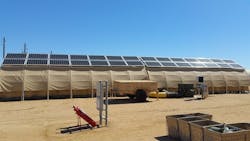Donna Lindner, of the US Air Force Research Laboratory, describes work under way to create a mobile microgrid that can be set up fast at forward operating bases.
Air Force expeditionary energy demo forges ahead Part of the Air Force Research Laboratory’s forward operating base of the future demonstration is one complete expeditionary microgrid system, pictured here during Basic Expeditionary Airmen Skills Training at Lackland Air Force Base in San Antonio, February 25, 2016. Monocrystalline silicon solar panels are placed on top of each tent for energy production. A trailer, at center, holds the hardware, software and lithium ion batteries that form the smart grid and provide energy backup should the grid fail. The project evaluates energy reduction technologies such as shelter insulation and efficient heating, ventilation and air conditioning systems. Air Force photo by Donna Lindner
Today’s expeditionary military forces require steady, reliable energy sources to power worldwide missions.
The APTO forward operating base of the future project plays a critical role in changing the way forward deployed forces will power missions in the future. The on-going project hopes to meet the Air Force Civil Engineer Center’s 2035 vision to create a totally deployable, self-sustaining power system. Progress over the past year has been enormous, resulting in new cross-service collaborations, successful equipment demonstrations and more.
“We learned a lot over the past year,” said Air Force 1st Lt. Jason Goins, project engineer. “We demonstrated feasibility and where to go next in terms of making complete microgrid systems. Pieces of individual equipment have been demonstrated separately, and by combining them into a microgrid we learned how well they worked synergistically.”
Mobile Energy Storage, Management System
Housed in a 10-foot-long trailer, a mobile, hybrid energy storage and management system able to supply renewable energy power for forward operating bases is the latest addition to the APTO-led effort to meet the long-term energy needs of military forces. Batteries and a microgrid command, control and communication software package can act as a power source, better able to supply on-site, mobile energy for expeditionary forces.
“We are taking what we learned and applying it to a rapidly deployable system,” Goins said. “We are looking at something that will be set up and deployed in an hour. If you can power a shelter in 30 minutes with affordable solar and wind, that’s spectacular.”
In addition to providing a reliable, steady source of power, the team is exploring solar panels that can be shot by a bullet and still remain operational.
The team is also working with industry to create a lightweight wind power package. This would employ a ground-based system with a bladed turbine that can be cranked up into the air to generate wind power.
The trailer’s open software system and architecture has played a critical role in enabling cross-service collaboration with the Army. The Army’s Research, Development and Engineering Command’s Communications-Electronics Research, Development and Engineering Center is performing joint testing and development of the mobile energy management system trailer. The results will be used to develop tactical microgrid standards.
In the coming months and years, the team plans to continue its partnership with the Army and look at ways they can collaborate on developing standard policies and equipment for microgrids — be alert for opportunities to leverage industry advancements in alternative power technology.
This article originated on the U.S. Department of Defense website.
Track news about mobile microgrids by subscribing to the Microgrid Knowledge newsletter. It’s free.







